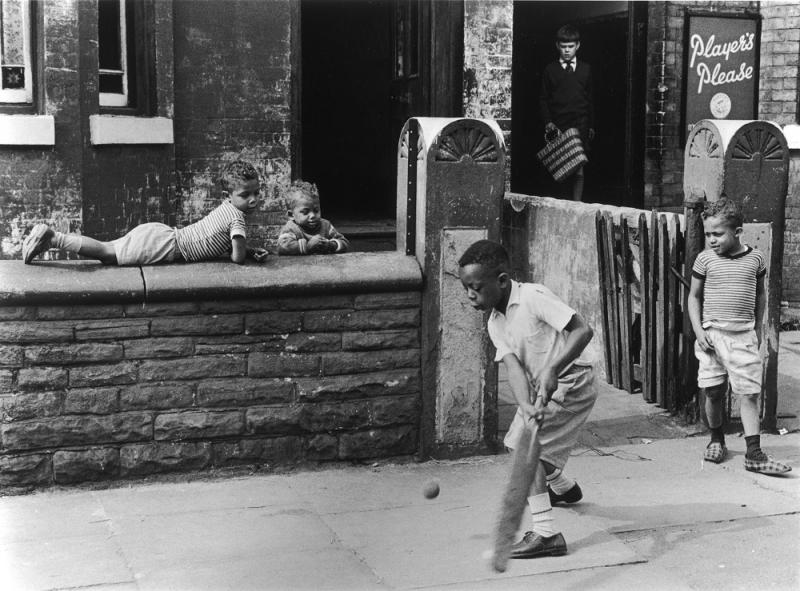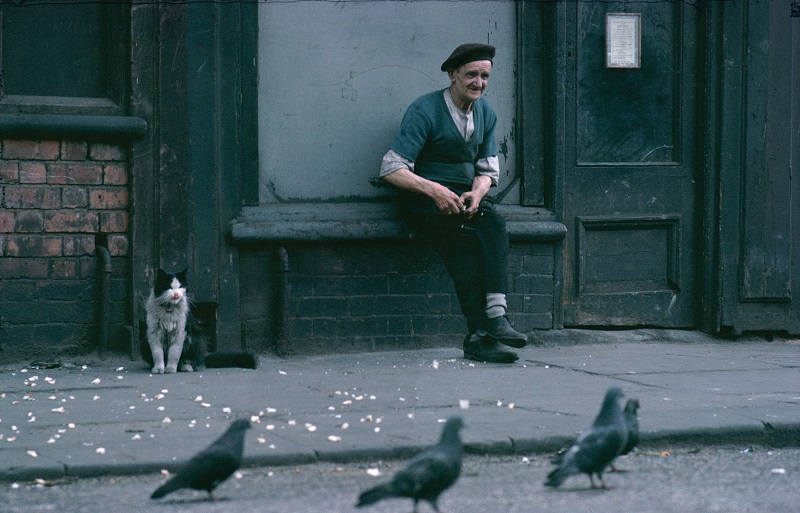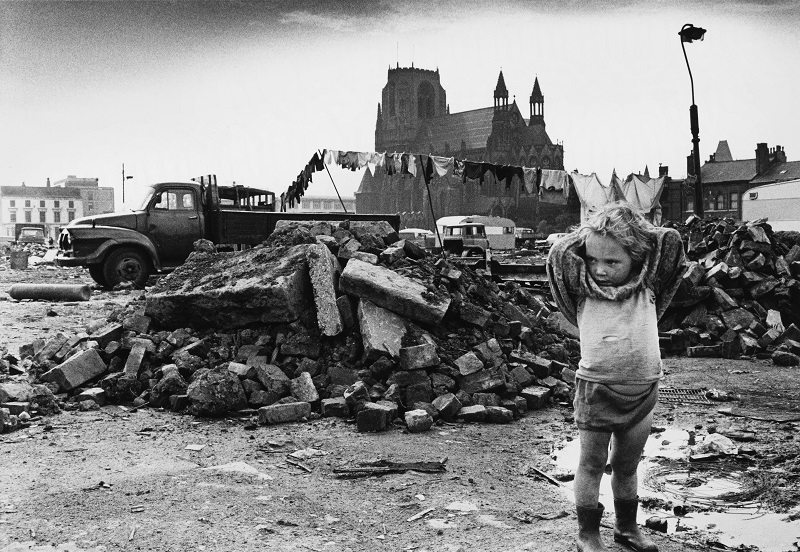Shirley Baker, Photographers' Gallery | reviews, news & interviews
Shirley Baker, Photographers' Gallery
Shirley Baker, Photographers' Gallery
A forgotten photographer of the northern slums is rediscovered

When a photographer is as little known as Shirley Baker, it is probably only natural that we scour her work for clues to the personality behind the camera. Certainly, Baker’s photographs of inner city Salford and Manchester, taken over a period of 20 years, seem to offer as full and intriguing a picture of Baker herself as of the disappearing communities she was committed to recording.
It is Baker's pictures of children that are the most telling: she was fascinated by what she perceived to be the "blissful innocence" enjoyed by inner city children, whom she pictures groping around inside a drain, playing in the open ruins of a part-demolished house or playing hopscotch and cricket in the street. Such freedom would be seen as neglect today, and since Baker was a middle-class woman married to a GP, the contrast with the restrictive upbringing of apparently more privileged children must have been striking.
The slums were a world apart from Baker's own genteel environs, and yet her pictures never romanticise what she sawShe certainly knew not only how to talk to children, but how to make them laugh. A picture from Manchester in 1962 shows three boys struggling to keep still and about to erupt into giggles, all gappy teeth and grins, but nevertheless relaxed and happy to be photographed. Part of Baker's secret lay in her choice of camera, a Rolleiflex which was perfect for the job. With the viewfinder on top, the camera had to be held at waist level, allowing a lower viewpoint ideally suited to shooting children, and leaving her face unobscured so that she was free to chat and make eye contact.
More fundamentally though, Baker’s readiness to use humour not only allowed her to form a bond with the people she photographed, but also steered her away from the common pitfalls of documentary photography. The slums were a world apart from Baker's own genteel environs, and yet her pictures never romanticise what she saw. She viewed it as her duty to record the destruction of great swathes of these northern cities, explaining: "I wanted to do something. But what could I do? I decided I would go out on the streets capturing this upheaval, photographing people I came across".
 A picture taken during a brief and in her view unsuccessful experiment with colour gives a vivid impression of Baker’s playful wit. An old man feeding pigeons in the street has a little echo in the cat sat next to him, whose black patches look much like the old man’s hat, which in turn finds an unlikely echo in the outlines of the pigeons (pictured above: Hulme, May 1965).
A picture taken during a brief and in her view unsuccessful experiment with colour gives a vivid impression of Baker’s playful wit. An old man feeding pigeons in the street has a little echo in the cat sat next to him, whose black patches look much like the old man’s hat, which in turn finds an unlikely echo in the outlines of the pigeons (pictured above: Hulme, May 1965).
Clearly, she was a familiar if eccentric local face; in one picture a group of boys acknowledge her with a friendly wave, while elsewhere she is greeted with something more like patient resignation. For all that, she never went indoors, not because she wasn’t invited, but because to accept would have been an imposition. Bill Brandt, who, decades before had photographed similar scenes of working-class life, was notably untroubled by such niceties and his pictures often make uncomfortable viewing. Scenes such as his famous Northumbrian miner at his evening meal, 1937, suggest that for Brandt people presented a spectacle along the lines of animals in a zoo.
Her story highlights how many women of Baker’s generation were denied professional careersWhile Brandt had a highly successful career and remains one of the great names of 20th-century photography, Baker was almost unheard of in her own lifetime, although she was a frequent winner of competitions in magazines such as Amateur Photographer. In a feature from 1970 entitled “How to photograph children”, Baker’s prizewinning talents were rather predictably put down to her gender, the standfirst proclaiming: “You’d expect a woman photographer to be at home with such a subject.”
Baker was a reluctant amateur, whose ambitions to work as a press photographer were never realised. A generation too late for the news magazines that had championed photojournalism in the Forties and Fifties, Baker applied to The Guardian, one of the few remaining publications that ran picture-led stories. But according to Baker: “The Guardian ran a ‘closed shop’ for their photographers, open only to men.” The editor liked her work, and accepted the odd picture, but she would never join the staff.
There is a depressing familiarity about Baker’s story, which is ostensibly one of ambition thwarted by sexism and the burdens of domesticity. Photography boasts many examples of extraordinary women, like Lee Miller and Margaret Bourke-White who threw themselves into the male-dominated world of war reportage and produced some of the most enduring images of the Second World War. In many ways, such glittering success stories are misleading, and tend to suggest that women with sufficient talent and determination would eventually succeed. The truth is probably more closely aligned to Shirley Baker's experience, and her story highlights how many women of Baker’s generation were denied professional careers; in fact, even today many women will recognise some of the obstacles that she faced.
 Nevertheless, even Baker herself acknowledged that her enforced amateur status ultimately benefited her work, giving her the freedom to pursue her own interests. Looking at her pictures now, time seems key to their success. Standing around, watching and waiting, revisiting the same places again and again, gave her a unique familiarity not just with the people, but also the places themselves. She was acutely aware of the physical environment her subjects inhabited and her sensitivity to its textures and contrasts, whether in puddles, bricks, chimney stacks, lace curtains, or the pieces of wood piled to make a bonfire, is essential to her command of black and white. (Pictured above: Manchester, 1968)
Nevertheless, even Baker herself acknowledged that her enforced amateur status ultimately benefited her work, giving her the freedom to pursue her own interests. Looking at her pictures now, time seems key to their success. Standing around, watching and waiting, revisiting the same places again and again, gave her a unique familiarity not just with the people, but also the places themselves. She was acutely aware of the physical environment her subjects inhabited and her sensitivity to its textures and contrasts, whether in puddles, bricks, chimney stacks, lace curtains, or the pieces of wood piled to make a bonfire, is essential to her command of black and white. (Pictured above: Manchester, 1968)
But the physical environment provided more than a textural palette to play with; her close-up pictures of graffiti seem curiously, even shockingly out of keeping with her time. Some of her best pictures use graffiti or advertising boards like a caption, providing a pithy counterpoint to an image. Much as Baker insisted that she never staged shots, these pictures self-evidently result from considerable thought, and she must have stood about waiting for the shot to come together, something that would have been far harder to achieve had she been a slave to deadlines.
Explore topics
Share this article
The future of Arts Journalism
You can stop theartsdesk.com closing!
We urgently need financing to survive. Our fundraising drive has thus far raised £49,000 but we need to reach £100,000 or we will be forced to close. Please contribute here: https://gofund.me/c3f6033d
And if you can forward this information to anyone who might assist, we’d be grateful.

Subscribe to theartsdesk.com
Thank you for continuing to read our work on theartsdesk.com. For unlimited access to every article in its entirety, including our archive of more than 15,000 pieces, we're asking for £5 per month or £40 per year. We feel it's a very good deal, and hope you do too.
To take a subscription now simply click here.
And if you're looking for that extra gift for a friend or family member, why not treat them to a theartsdesk.com gift subscription?
more Visual arts
 'We are bowled over!' Thank you for your messages of love and support
Much-appreciated words of commendation from readers and the cultural community
'We are bowled over!' Thank you for your messages of love and support
Much-appreciated words of commendation from readers and the cultural community
![SEX MONEY RACE RELIGION [2016] by Gilbert and George. Installation shot of Gilbert & George 21ST CENTURY PICTURES Hayward Gallery](https://theartsdesk.com/sites/default/files/styles/thumbnail/public/mastimages/Gilbert%20%26%20George_%2021ST%20CENTURY%20PICTURES.%20SEX%20MONEY%20RACE%20RELIGION%20%5B2016%5D.%20Photo_%20Mark%20Blower.%20Courtesy%20of%20the%20Gilbert%20%26%20George%20and%20the%20Hayward%20Gallery._0.jpg?itok=7tVsLyR-) Gilbert & George, 21st Century Pictures, Hayward Gallery review - brash, bright and not so beautiful
The couple's coloured photomontages shout louder than ever, causing sensory overload
Gilbert & George, 21st Century Pictures, Hayward Gallery review - brash, bright and not so beautiful
The couple's coloured photomontages shout louder than ever, causing sensory overload
 Lee Miller, Tate Britain review - an extraordinary career that remains an enigma
Fashion photographer, artist or war reporter; will the real Lee Miller please step forward?
Lee Miller, Tate Britain review - an extraordinary career that remains an enigma
Fashion photographer, artist or war reporter; will the real Lee Miller please step forward?
 Kerry James Marshall: The Histories, Royal Academy review - a triumphant celebration of blackness
Room after room of glorious paintings
Kerry James Marshall: The Histories, Royal Academy review - a triumphant celebration of blackness
Room after room of glorious paintings
 Folkestone Triennial 2025 - landscape, seascape, art lovers' escape
Locally rooted festival brings home many but not all global concerns
Folkestone Triennial 2025 - landscape, seascape, art lovers' escape
Locally rooted festival brings home many but not all global concerns
 Sir Brian Clarke (1953-2025) - a personal tribute
Remembering an artist with a gift for the transcendent
Sir Brian Clarke (1953-2025) - a personal tribute
Remembering an artist with a gift for the transcendent
 Emily Kam Kngwarray, Tate Modern review - glimpses of another world
Pictures that are an affirmation of belonging
Emily Kam Kngwarray, Tate Modern review - glimpses of another world
Pictures that are an affirmation of belonging
 Kiefer / Van Gogh, Royal Academy review - a pairing of opposites
Small scale intensity meets large scale melodrama
Kiefer / Van Gogh, Royal Academy review - a pairing of opposites
Small scale intensity meets large scale melodrama
 Jenny Saville: The Anatomy of Painting, National Portrait Gallery review - a protégé losing her way
A brilliant painter in search of a worthwhile subject
Jenny Saville: The Anatomy of Painting, National Portrait Gallery review - a protégé losing her way
A brilliant painter in search of a worthwhile subject
 Abstract Erotic, Courtauld Gallery review - sculpture that is sensuous, funny and subversive
Testing the boundaries of good taste, and winning
Abstract Erotic, Courtauld Gallery review - sculpture that is sensuous, funny and subversive
Testing the boundaries of good taste, and winning
 Edward Burra, Tate Britain review - watercolour made mainstream
Social satire with a nasty bite
Edward Burra, Tate Britain review - watercolour made mainstream
Social satire with a nasty bite
 Ithell Colquhoun, Tate Britain review - revelations of a weird and wonderful world
Emanations from the unconscious
Ithell Colquhoun, Tate Britain review - revelations of a weird and wonderful world
Emanations from the unconscious

Add comment